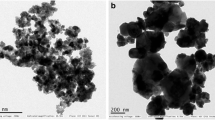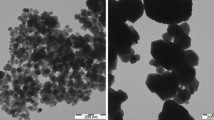Abstract
This study aims to evaluate the effects of maghemite nanoparticles (γ-Fe2O3) coated with meso-2, 3-dimercaptosuccinic acid (DMSA) stabilizer on the survival and reproduction of the aquatic snail Biomphalaria glabrata. The cumulative means of egg masses and eggs per individual in the control group at the end of 4 weeks were 18.8 and 326.7, respectively. These values at the concentration of 1 mg/L were 17.2 and 291.6; at 10 mg/L, they were 19.6 and 334.4 ,and at 100 mg/L, they were 14.3 and 311.1. Results showed no significant differences between the tested and the control groups at the level of p < 0.05. Exposure of embryos for 10 days showed absence of mortality, malformation, or hatching delay. X-ray microtomography confirmed the presence of nanoparticles in exposed individuals and showed the complete elimination of the nanoparticles after 30 days in clean water. In the studied conditions, it is clear that γ-Fe2O3 coated with stabilizing DMSA did not alter the fecundity or the fertility of the snail B. glabrata after 4 weeks of exposure, and accumulation was not present after 30 days in clean water.






Similar content being viewed by others
References
Azam A, Ahmed AS, Oves M, Khan MS, Habib SS, Memic A (2012) Antimicrobial activity of metal oxide nanoparticles against gram-positive and gram-negative bacteria: a comparative study. Int J Nanomedicine 7:6003–6009
Bellavere C, Gorbi J (1981) Comparative analysis of acute toxicity of chromium, copper and cadmium to Daphnia magna, Biomphalaria glabrata and Brachydanio rerio. Environ Technol Lett 2:119–128
Benkendorff K, Davis AR, Bremmer JB (2001) Chemical defense in the egg masses of benthic invertebrates: an assessment of antibacterial activity in 39 mollusks and 4 polychaetes. J Invertebr Pathol 78:109–118
Camey T, Verdonk NH (1968) The early development of the snail Biomphalaria glabrata (say) and the origin of the head organs. Neth J Zool 20:93–121
Cheng J, Flahaut E, Cheng SH (2007) Effect of carbon nanotubes on developing zebrafish (Danio rerio) embryos. Environ Toxicol Chem 26:708–716
Dunnett CW (1955) Multiple comparison procedure for comparing several treatments with a control. J Am Stat Assoc 50:1096–1121
Farré M, Gajda-Schrantz K, Kantiani L, Barceló D (2009) Ecotoxicity and analysis of nanomaterials in the aquatic environment. Anal Bioanal Chem 393:81–95
Fauconnier N, Pons J, Roger J, Bee A (1997) Thiolation of maghemite nanoparticles by dimercaptosuccinic acid. J Colloid Interface Sci 194:427–477
Geoprincy G, Nagendhira Ghandhi N, Renganathan S (2012) Novel antibacterial effects of alumina nanoparticles on Bacillus cereus and Bacillus subtilis in comparison with antibiotics. Int J Pharm Pharm Sci 4:544–548
Gupta AK, Gupta M (2005) Synthesis and surface engineering of iron oxide nanoparticles for biomedical applications. Biomaterials 26:3995–4021
Hajipour MJ, Fromm KM, Ashkarran AA, Jimenez de Aberasturi D, de Larramendi IR, Rojo T, Serpooshan V, Parak WJ, Mahmoudi M (2012) Antibacterial properties of nanoparticles. Trends Biotechnol 30:499–511
Hamilton MA, Russo RC, Thurston RV (1977) Trimmed spearman-Karber method for estimating median lethal concentrations in toxicity bioassays. Environ Sci Technol 11:714–719
Handy RD, Owen R, Valsami-Jones E (2008) The ecotoxicology of nanoparticles and nanomaterials: current status, knoledge gaps, challenges, and future needs. Ecotoxicology 17:315–325
Hathaway JJ, Adema CM, Stout BA, Mobarak CD, Loker ES (2010) Identification of protein components of egg masses indicates parental investment in immunoprotection of offspring by Biomphalaria glabrata (Gastropoda, Mollusca). Dev Comp Immunol 34:425–435
Hu J, Wang D, Wang J, Wang J (2012) Bioaccumulation of Fe2O3 (magnetic nanoparticles) in Ceriodaphnia dubia. Environ Pollut 162:216–222
Jenneson PM, Luggar RD, Morton EJ, Gundogdu O, Tüzün U (2004) Examining nanoparticle assemblies using high spatial resolution x-ray microtomography. J Appl Phys 96:2889–2894
Kahru A, Dubourguier HC (2010) From ecotoxicology to nanoecotoxicology. Toxicology 269:105–119
Kawano T, Okazaki K, Ré L (1992) Embryonic development of Biomphalaria glabrata (say, 1818) (Mollusca, Gastropoda, Planorbidae): a practical guide to the main stages. Malacologia 34:25–32
Marxen JC, Prymak O, Beckmann F, Neues F, Epple M (2008) Embryonic shell formation in the snail Biomphalaria glabrata: a comparison between scanning electron microscopy (SEM) and synchrotron radiation microcomputer tomography (SRμCT). J Molluscan Stud 74:19–25
Mukherjee A, Mohammed Sadiq I, Prathna TC, Chandrasekaran N (2011) Antimicrobial activity of aluminium oxide nanoparticles for potential clinical applications. In: Méndez-Vilas A (ed) Science against microbial pathogens: communicating current research and technological advances. Badajoz, Formatex Research Center, pp. 245–251
Münzinger A (1987) Biomphalaria glabrata (say), a suitable organism for a biotest. Environ Technol Lett 8:141–148
Musee N, Oberholster PJ, Sikhwivhilu L, Botha AM (2010) The effects of engineered nanoparticles on survival, reproduction, and behaviour of freshwater snail, Physa acuta (Draparnaud, 1805). Chemosphere 81:1196–1203
Nations S, Wages M, Cañas JE, Maul J, Theodorakis C, Cobb GP (2011) Acute effects of Fe2O3, TiO2, ZnO and CuO nanomaterials on Xenopus laevis. Chemosphere 83:1053–1061
Oliveira-Filho EC, Geraldino BR, Coelho DR, De-Carvalho RR, Paumgartten FJR (2010) Comparative toxicity of Euphorbia milii latex and synthetic molluscicides to Biomphalaria glabrata embryos. Chemosphere 80:218–227
Oliveira-Filho EC, Geraldino BR, Grisolia CK, Paumgartten FJR (2005) Acute toxicity of endosulfan, nonylphenol ethoxylate, and ethanol to different life stages of the freshwater snail Biomphalaria tenagophila (Orbigny, 1835). Bull Environ Contam Toxicol 75:1185–1190
Oliveira-Filho EC, Grisolia CK, Paumgartten FJR (2009a) Trans-generation study of the effects of nonylphenol ethoxylate on the reproduction of the snail Biomphalaria tenagophila. Ecotoxicol Environ Saf 72:458–465
Oliveira-Filho EC, Grisolia CK, Paumgartten FJR (2009b) Effects of endosulfan and ethanol on the reproduction of the snail Biomphalaria tenagophila: a multigeneration study. Chemosphere 75:398–404
Petersen EJ, Akkanen J, Kukkonen JVK, Weber WJ (2009) Biological uptake and depuration of carbon nanotubes by Daphnia magna. Environ Sci Technol 43:2969–2975
Ravera O (1977) Effects of heavy metals (cadmium, copper, chromium and lead) on a freshwater snail: Biomphalaria glabrata Say (Gastropoda, Prosobranchia). Malacologia 16:231–236
Stern ST, Mcneil SE (2008) Nanotechnology safety concerns revisited. Toxicol Sci 101:4–21
Tervonen K, Waissi G, Petersen EJ, Akkanen J, Kukkonen JV (2010) Analysis of fullerene-C60 and kinetic measurements for its accumulation and depuration in Daphnia magna. Environ Toxicol Chem 29:1072–1078
USEPA (2002) Short-term methods for estimating the chronic toxicity of effluents and receiving waters to freshwater organisms. USEPA, Washington Available at: http://water.epa.gov/scitech/methods/cwa/wet/upload/2007_07_10_methods_wet_disk3_ctf1-6.pdf. Accessed 6 April 2015
Van Ewijk G, Vroege G, Philipse A (1999) Convenient preparation methods for magnetic colloids. J Magn Magn Mater 201:31–33
Zhu X, Chang Y, Chen Y (2010) Toxicity and bioaccumulation of TiO2 nanoparticle aggregates in Daphnia magna. Chemosphere 78:209–215
Zhu X, Tian S, Cai Z (2012) Toxicity assessment of iron oxide nanoparticles in zebrafish (Danio rerio) early life stages. PLoS One 7:e46286
Acknowledgments
Luana Arreguy Novais received a fellowship from the CNPq/UniCEUB program. The research was supported by the Brazilian National Research Council (CNPq) grant 552113/2011-5. This paper is dedicated to the memory of Jose de Souza Filho.
Author information
Authors and Affiliations
Corresponding author
Ethics declarations
Conflict of interest
The authors declare that they have no competing interests.
Additional information
Responsible editor: Thomas Braunbeck
José Sousa Filho is deceased.
Rights and permissions
About this article
Cite this article
Oliveira-Filho, E.C., Filho, J.S., Novais, L.A. et al. Effects of γ-Fe2O3 nanoparticles on the survival and reproduction of Biomphalaria glabrata (Say, 1818) and their elimination from this benthic aquatic snail. Environ Sci Pollut Res 23, 18362–18368 (2016). https://doi.org/10.1007/s11356-016-6998-1
Received:
Accepted:
Published:
Issue Date:
DOI: https://doi.org/10.1007/s11356-016-6998-1




